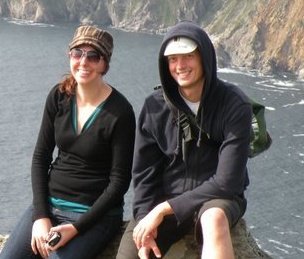05/22/2022
Lynn Murphy Mark
Luck of the Irish
In 2009, I finally made it to Ireland. I took my kids and we spent 8 awesome days on that gorgeous green island. We started in Dublin, doing some touristy stuff like taking the Guiness brewery tour and visiting Newgrange, Ireland’s most famous passage tomb. The Guiness tour was really interesting. As we walked up each level of the building we encountered another phase of beer making. Then we got to the top and a pint of that dark, nutritious beer was waiting for us. Not only that, we were in a round room with windows overlooking Dublin.
Newgrange deserves its own paragraph. A bus drove us through the breathtaking surroundings of rural Ireland. We followed the River Boyne. The river water is a dark brown, like weak coffee, presumably due to high levels of tannin. We got to the busy parking area. The tour guide told us that we were going to approach a stone structure built in 3,200 BC. That, plus 2009, made the building 5,209 years old. Older than Stonehenge. Older than the great pyramids at Giza. Historians and archaeologists believe that it is more than a passage tomb, that it also served as a place of worship, much like a modern day cathedral. One of its famous features is the location of a small opening that, on the days around the Winter Solstice, is positioned so that a ray of sunshine penetrates the 19 meter passageway and shines into the burial chamber.
Newgrange sits on top of a hill. That means that the hundreds of stones that make its structure had to be transported uphill. There are 97 huge kerbstones that ring the base of Newgrange. It’s estimated that the structure weighs 200,000 tons and took over 30 years to build. This, built before trucks or cranes were available, means that muscle power and ingenious portage methods were used by the Stone Age builders. As I marveled at this engineering miracle I wondered if any of our modern day buildings will still be standing in 5,200 years.
When we were finished in Dublin, we rented a car to drive up North and find the place where some of our Murphy ancestors came from. Mind you, the name “Murphy” is as common in Ireland as “Jones” is in the U.S. of A. We were going on some information that Murphy cousins had put together years before.
Driving in Ireland is a trip all by itself. It didn’t help that it was a) a small vehicle, b) a manual transmission car and, c) it is required to drive on the opposite side of what we are used to here in the States. So, there I was sitting on what should have been the passenger side, shifting a manual knob with my left hand. The kids, both quite tall, were crammed into the back. I know for a fact that there were times when they were terrified. Country roads in Ireland are very narrow, trucks race on them like Nascar vehicles, and it never looks like there’s enough room for two vehicles to avoid brushing the stone walls that ring each patch of green meadow.
We spent two delightful days at a gorgeous bed and breakfast owned by the brother of our friend, Sister Mary. Then we took off for County Donegal, specifically a small town called Pettigoe, where we hoped to find the tombs of ancestors. Pettigoe literally sits on the line that divides Northern Ireland and “regular” Ireland. There is a sweet inn there where we had lunch and raised a pint to the Murphy’s that came before us.
The time came to turn in the rental car and end our trip. We found a great pub in Dublin, drank Guiness and Jameson’s, and listened to some great music. The Irish have an awesome and well developed sense of rhythm which further endeared me to the Emerald Isle. I loved its countryside, its craggy coasts, its friendly people, its history. I long for a time when I can go back. The picture attached to this blog is of my children at the cliffs of Donegal.

